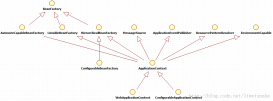文件上传主要分以下几个步骤:
(1)新建maven java project;
(2)在pom.xml加入相应依赖;
(3)新建一个表单页面(这里使用thymleaf);
(4)编写controller;
(5)测试;
(6)对上传的文件做一些限制;
(7)多文件上传实现
(1)新建maven Java project
新建一个名称为spring-boot-fileupload maven Java项目;
(2)在pom.xml加入相应依赖;
加入相应的maven依赖,具体看以下解释:
|
1
2
3
4
5
6
7
8
9
10
11
12
13
14
15
16
17
18
19
20
21
22
23
24
25
26
27
28
29
30
31
32
33
34
35
36
37
38
39
40
41
42
43
44
|
<project xmlns="http://maven.apache.org/POM/4.0.0" xmlns:xsi="http://www.w3.org/2001/XMLSchema-instance" xsi:schemaLocation="http://maven.apache.org/POM/4.0.0 http://maven.apache.org/xsd/maven-4.0.0.xsd"> <modelVersion>4.0.0</modelVersion> <groupId>com.example</groupId> <artifactId>spring-boot-fileupload</artifactId> <version>0.0.1-SNAPSHOT</version> <!-- spring boot 父节点依赖, 引入这个之后相关的引入就不需要添加version配置, spring boot会自动选择最合适的版本进行添加。 --> <parent> <groupId>org.springframework.boot</groupId> <artifactId>spring-boot-starter-parent</artifactId> <version>1.4.0.RELEASE</version> </parent> <dependencies> <!-- spring boot web支持:mvc,aop... --> <dependency> <groupId>org.springframework.boot</groupId> <artifactId>spring-boot-starter-web</artifactId> </dependency> <!-- thmleaf模板依赖. --> <dependency> <groupId>org.springframework.boot</groupId> <artifactId>spring-boot-starter-thymeleaf</artifactId> </dependency> </dependencies> <build> <plugins> <!-- 编译版本; --> <plugin> <artifactId>maven-compiler-plugin</artifactId> <configuration> <source>1.7</source> <target>1.7</target> </configuration> </plugin> </plugins> </build> </project> |
(3)新建一个表单页面(这里使用thymleaf)
在src/main/resouces新建templates,在templates下新建一个file.html:
|
1
2
3
4
5
6
7
8
9
10
11
12
13
14
15
16
17
18
|
<!DOCTYPE html> <html xmlns="http://www.w3.org/1999/xhtml" xmlns:th="http://www.thymeleaf.org" xmlns:sec="http://www.thymeleaf.org/thymeleaf-extras-springsecurity3"> <head> <title>Hello World!</title> </head> <body> <form method="POST" enctype="multipart/form-data" action="/upload"> <p> 文件:<input type="file" name="file" /> </p> <p> <input type="submit" value="上传" /> </p> </form> </body> </html> |
(4)编写controller;
编写controller进行测试,这里主要实现两个方法:其一就是提供访问的/file路径;其二就是提供post上传的/upload方法,具体看代码实现:
|
1
2
3
4
5
6
7
8
9
10
11
12
13
14
15
16
17
18
19
20
21
22
23
24
25
26
27
28
29
30
31
32
33
34
35
36
37
38
39
40
41
42
43
44
45
46
47
48
49
50
51
52
53
|
@Controllerpublic class FileUploadController { // 访问路径为:http://127.0.0.1:8080/file @RequestMapping("/file") public String file() { return "/file"; } /** * 文件上传具体实现方法; * * @param file * @return */ @RequestMapping("/upload") @ResponseBody public String handleFileUpload(@RequestParam("file") MultipartFile file) { if (!file.isEmpty()) { try { /* * 这段代码执行完毕之后,图片上传到了工程的跟路径; 大家自己扩散下思维,如果我们想把图片上传到 * d:/files大家是否能实现呢? 等等; * 这里只是简单一个例子,请自行参考,融入到实际中可能需要大家自己做一些思考,比如: 1、文件路径; 2、文件名; * 3、文件格式; 4、文件大小的限制; */ BufferedOutputStream out = new BufferedOutputStream( new FileOutputStream(new File( file.getOriginalFilename()))); out.write(file.getBytes()); out.flush(); out.close(); } catch (FileNotFoundException e) { e.printStackTrace(); return "上传失败," + e.getMessage(); } catch (IOException e) { e.printStackTrace(); return "上传失败," + e.getMessage(); } return "上传成功"; } else { return "上传失败,因为文件是空的."; } } // 访问路径为:http://127.0.0.1:8080/file @RequestMapping("/mutifile") public String mutifile() { return "/mutifile"; } |
(5)编写Application.java然后测试
Application没什么代码,就是Spring Boot的启动配置,具体如下:
|
1
2
3
4
5
6
7
8
9
10
11
12
13
14
15
16
17
|
package com.example.controller; import javax.servlet.MultipartConfigElement; import org.springframework.boot.SpringApplication; import org.springframework.boot.autoconfigure.SpringBootApplication; //import org.springframework.boot.context.embedded.MultipartConfigFactory; import org.springframework.boot.web.servlet.MultipartConfigFactory; import org.springframework.context.annotation.Bean; @SpringBootApplicationpublic class Application { public static void main(String[] args) { SpringApplication.run(Application.class, args); } } |
然后你就可以访问:http://127.0.0.1:8080/file 进行测试了,文件上传的路径是在工程的跟路径下,请刷新查看,其它的请查看代码中的注释进行自行思考
(6)对上传的文件做一些限制;
对文件做一些限制是有必要的,在Application.java进行编码配置:。
|
1
2
3
4
5
6
7
8
9
10
11
|
@Bean public MultipartConfigElement multipartConfigElement() { MultipartConfigFactory factory = new MultipartConfigFactory(); //// 设置文件大小限制 ,超了,页面会抛出异常信息,这时候就需要进行异常信息的处理了; factory.setMaxFileSize("128KB"); //KB,MB /// 设置总上传数据总大小 factory.setMaxRequestSize("256KB"); //Sets the directory location where files will be stored. //factory.setLocation("路径地址"); return factory.createMultipartConfig(); } |
(7)多文件上传实现
多文件对于前段页面比较简单,具体代码实现:
在src/resouces/templates/mutifile.html
|
1
2
3
4
5
6
7
8
9
10
11
12
13
14
15
|
<!DOCTYPE html> <html xmlns="http://www.w3.org/1999/xhtml" xmlns:th="http://www.thymeleaf.org" xmlns:sec="http://www.thymeleaf.org/thymeleaf-extras-springsecurity3"> <head> <title>Hello World!</title> </head> <body> <form method="POST" enctype="multipart/form-data" action="/batch/upload"> <p>文件1:<input type="file" name="file" /></p> <p>文件2:<input type="file" name="file" /></p> <p>文件3:<input type="file" name="file" /></p> <p><input type="submit" value="上传" /></p> </form> </body> </html> |
FileUploadController中新增两个方法:
|
1
2
3
4
5
6
7
8
9
10
11
12
13
14
15
16
17
18
19
20
21
22
23
24
25
26
27
28
29
30
31
32
33
34
35
36
37
38
39
40
41
42
43
44
45
|
// 访问路径为:http://127.0.0.1:8080/mutifile @RequestMapping("/mutifile") public String mutifile() { return "/mutifile"; } /** * 多文件具体上传时间,主要是使用了MultipartHttpServletRequest和MultipartFile * * @param request * @return */ @RequestMapping(value = "/batch/upload", method = RequestMethod.POST) @ResponseBody public String handleFileUpload(HttpServletRequest request) { List<MultipartFile> files = ((MultipartHttpServletRequest) request) .getFiles("file"); MultipartFile file = null; BufferedOutputStream stream = null; for (int i = 0; i < files.size(); ++i) { file = files.get(i); if (!file.isEmpty()) { try { byte[] bytes = file.getBytes(); stream = new BufferedOutputStream(new FileOutputStream( new File(file.getOriginalFilename()))); stream.write(bytes); stream.close(); } catch (Exception e) { stream = null; return "You failed to upload " + i + " => " + e.getMessage(); } } else { return "You failed to upload " + i + " because the file was empty."; } } return "upload successful"; } |
访问路径:http://127.0.0.1:8080/mutifile 进行测试。
以上就是本文的全部内容,希望对大家的学习有所帮助,也希望大家多多支持服务器之家。
原文链接:http://blog.csdn.net/u014695188/article/details/52398239














